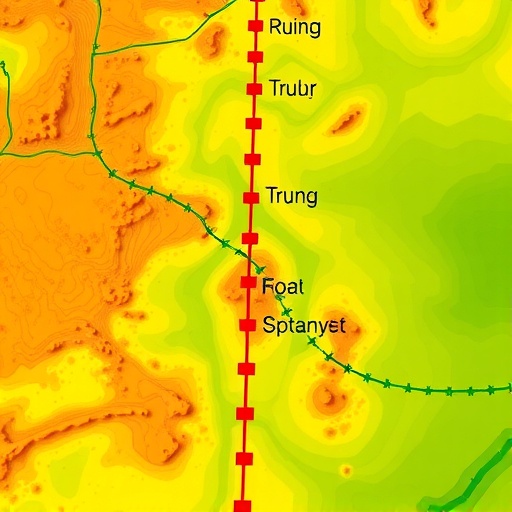The intricate world of surface mining has consistently presented its fair share of environmental challenges, among which flyrock hazards stand out as particularly dangerous. Flyrock refers to the rock fragments that are ejected from a blast site, often at high velocities, posing serious risks to both personnel and equipment. Traditional methods of assessing and predicting these hazards rely heavily on historical data, intuition, and experience. However, a groundbreaking study has entered the fray, aiming to revolutionize the prediction of flyrock events by leveraging advanced machine learning techniques.
This recent research, driven by Schrani, Hasanipanah, and Yin, prominently features the use of optimized gradient boosting models. These sophisticated algorithms are designed to enhance the predictability of flyrock hazards by analyzing an array of data that includes geological and operational parameters. The optimized gradient boosting models function by constructing strong predictive models through the combination of several weaker models, thereby amplifying precision and accuracy in predicting potential hazards.
It is worth noting that surface mining operations often occur in unpredictable and complex environments, where various factors can influence blast outcomes. Traditionally, flyrock has been assessed based on empirical rules or simplistic models that may fail to account for the multifaceted nature of geological formations. The introduction of optimized gradient boosting models marks a significant shift not only in methodology but also in the mindset towards real-time data integration and proactive hazard management in surface mining.
What sets this study apart is the rigorous methodology employed by the researchers. They compiled an extensive dataset that spanned multiple mining sites and conditions, allowing them to train their models on diverse scenarios. This breadth of data not only improved the models’ robustness but also their generalization capabilities, meaning they can accurately predict hazards even when applied to new and unseen mining environments.
The findings from this research are nothing short of remarkable. Not only did the optimized models demonstrate a higher level of accuracy compared to traditional prediction methods, but they also provided valuable insights into the contributing factors of flyrock events. By decoding these factors, mining operations can adopt a more strategic approach, adjusting their blast designs or operational protocols accordingly to mitigate risks effectively.
The implications of this research extend far beyond the immediate safety benefits. Improved prediction models can lead to significant cost savings for mining companies. By reducing the occurrence of flyrock incidents, companies can decrease downtime, damage to equipment, and potential liability claims, creating a more sustainable operational model in the long run.
Moreover, this work underscores the importance of integrating artificial intelligence (AI) and machine learning into traditional industries like mining. As these fields evolve, leveraging data-driven insights will become increasingly vital. The mining industry, often characterized by its conservative approach to change, may find itself at a pivotal juncture where embracing technological advancements is not merely beneficial but essential for future success.
The commitment of Rouhani and colleagues to enhance worker safety aligns perfectly with ongoing global initiatives to promote responsible mining practices. The utilization of machine learning models represents a proactive step towards safeguarding the environment and ensuring the safety of miners, a critical consideration in today’s regulatory environment where accountability is paramount.
This study offers a clarion call for the mining industry to invest in robust analytical frameworks that can predict and prevent hazards before they escalate into accidents. The transition to data-centric approaches is not just an option but a necessity in enhancing operational efficiencies, ultimately supporting the broader goals of environmental stewardship and social responsibility.
Going forward, it will be interesting to see how this research sparks further exploration and innovation within the sector. Will more mining companies adopt sophisticated analytics as a means of optimizing their operations? Hopefully, this study will catalyze further advancements in not just flyrock prediction, but also in other areas where machine learning can redefine operational protocols in aggregate extraction.
As the findings circulate within the scientific and industrial communities, it is evident that the foundation for intelligent, data-driven decision-making in surface mining has been firmly established. The path towards safer and more efficient mining operations is being paved with research that emphasizes the synergy between technology and field expertise, opening up new avenues for cross-disciplinary collaboration.
In summary, the work conducted by Rouhani, Hasanipanah, and Yin provides a compelling case for the role of advanced computational models in revolutionizing safety protocols within the mining industry. Their exploration of optimized gradient boosting models stands testament to the transformative potential of machine learning, setting a standard for future research and development practices.
The intricacies of flyrock hazards and their prediction unveil a broader narrative concerning the nexus of technology, safety, and sustainability in resource extraction. As the industry faces inevitable challenges posed by environmental scrutiny and resource demands, embracing intelligent prediction systems may offer the state-of-the-art solutions necessary to navigate these complexities effectively.
Ultimately, the study serves as an inspiration not just for miners but for any industrial application where safety and efficiency must coexist harmoniously. It underscores the need for continuous investment in innovative approaches that prioritize both human life and environmental integrity, heralding a new era of responsible mining.
Subject of Research: Intelligent Prediction of Flyrock Hazards in Surface Mining
Article Title: Intelligent Prediction of Flyrock Hazards in Surface Mining Using Optimized Gradient Boosting Models
Article References:
Rouhani, M.M., Hasanipanah, M., Yin, X. et al. Intelligent Prediction of Flyrock Hazards in Surface Mining Using Optimized Gradient Boosting Models. Nat Resour Res (2025). https://doi.org/10.1007/s11053-025-10546-2
Image Credits: AI Generated
DOI:
Keywords: Surface mining, flyrock hazards, machine learning, optimized gradient boosting, predictive modeling, mining safety, data-driven insights.




